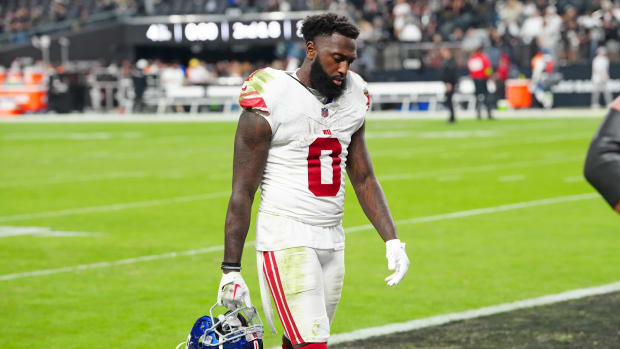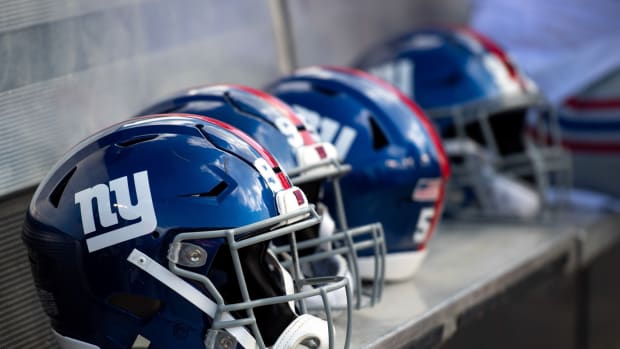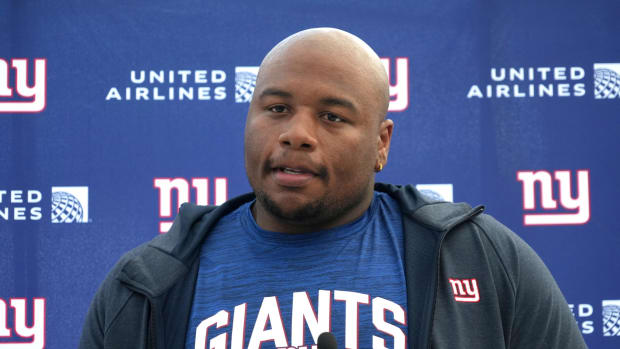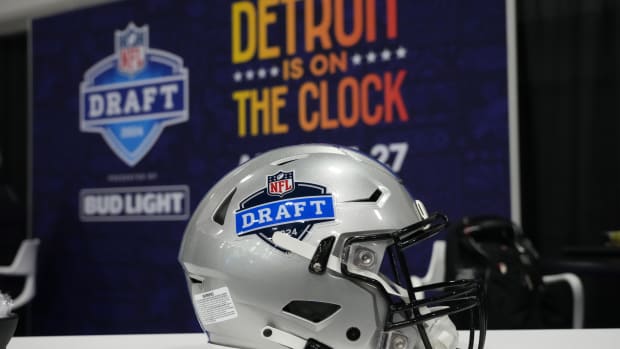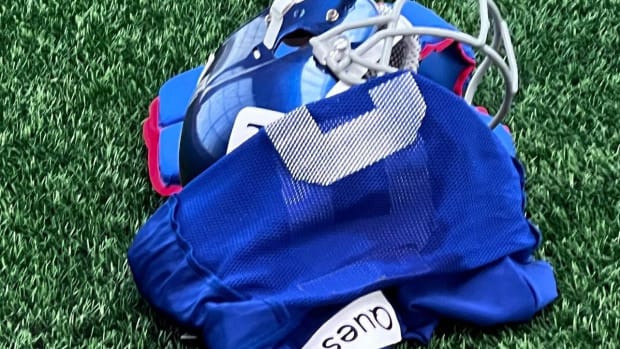New York Giants 2024 Draft Preview: Best Interior Offensive Line Fits
The Giants loaded up on interior offensive linemen in free agency, but could they use more from the draft?
The New York Giants' offensive line was historically bad last season when it came to protecting the quarterback. But it's quite a revelation when one dives into the data to see just how bad the line really was.
According to a study by Daniel Salib using data from Pro Football Focus), the Giants interior offensive linemen were most responsible for the poor overall play of the unit, the guards and centers allowing a league-leading 27 sacks (versus 13 allowed by the tackles).
(The study, per Salib, doesn’t include sacks attributed to the quarterback or skill position players.)
Thus, it was no surprise that the team emphasized getting this unit squared away once and for all. Head coach Brian Daboll fired offensive line coach Bobby Johnson and replaced him with former Raiders offensive line coach Carmen Bricillo.
General manager Joe Schoen put a heavy emphasis on yet another attempt at fixing this unit, signing guard Jon Runyan Jr. to lock down one guard spot and veteran guard/tackle Jermaine Eluemunor to anchor the other (assuming he doesn’t have to step in for Evan Neal at tackle should Neal struggle again).
The Giants also added interior depth in Austin Stinnie and Aaron Schlottmann to a group that includes holdovers Joshua Ezeudu and Marcus McKethan, both draft picks from a couple of years ago.
There are a lot of bodies for Bricillo to work with, but the question isn’t so much about quantity as it is about quality. Bricillo has a reputation for working wonders with subpar offensive line talent—can he do the same for the Giants to get that unit fixed once and for all?
Other Draft Position Previews
Quarterbacks | Running Backs | Tight Ends | Receivers | Defensive Line | Inside Linebackers
Outside Linebackers | Safeties | Cornerbacks | Offensive Tackles
Where Do Ezeudu and McKethan Fit In?
Joshua Ezeudu and Marcus McKethan were 22022 draft picks, the former a third-rounder and the latter a fifth-rounder. Both have intriguing toolsets, but thus far, due in part to injuries and a lack of consistency likely a result of coaching, both have struggled to seize the bull by the horns and grab a starting spot.
Last year, Ezeudu, who played tackle at North Carolina, got a chance to play left tackle, a position that he hadn’t worked at since coming to the Giants. He predictably struggled before a turf toe injury ended his season.
McKethan didn’t fare much better. He got an opportunity to start at right guard last season after the team decided to bench Mark Glowinski, but that opportunity was short-lived when McKethan struggled.
To be fair to both youngsters, they were thrust into opportunities for which they likely weren’t set up to succeed. That said, it’s also fair to wonder what the Giants think about both young men’s future. With proper coaching, can they develop into what the team hoped they’d become when they drafted them?
Some might say that all the veterans Schoen brought answered the question loud and clear. If Schen adds an interior offensive lineman to the mix, that will only punctuate the statement.
Prospects
Day 1: Graham Barton (G/C, Duke)
Barton might not (quite) be the best interior lineman in this draft class, if only because he’ll have to transition inside. However, he could be the first lineman off the board to play inside at the NFL level.
Barton has been the Blue Devils’ left tackle, but his future is likely inside at guard or center (where he has played some). His 32 ⅞ inch arms could well come in below some teams’ thresholds for an offensive tackle, and Barton doesn’t quite have the lower body fluidity to cover ground on the edge as a tackle in the NFL.
That, however, isn’t a problem on the offensive interior and playing there will allow him to maximize his play strength and improve his technique. Barton could easily follow in the footsteps of Justin Pugh or Zack Martin at the NFL level.
Day 2/3: Christian Haynes (OG, UConn)
Christian Haynes was a bright spot on the Huskies’ offense and a legitimate problem for opposing defensive linemen.
Haynes is a very dependable pass protector who has only given up three (3) sacks in more than 2,400 snaps at right guard. He also has very good play strength to manhandle defenders as a run blocker and the springy athleticism to match up with pass rushers along the interior. Haynes might be limited by his experience coming solely at right guard, but he can start immediately at right guard for any team with an opening.
Cooper Beebe (OG, Kansas State)
Beebe is a stocky, experienced, and powerful guard. He’s logged over 2,600 snaps at Kansas State and has obvious strength in his 6-foot-3, 325-pound frame. Beebe was listed at 335 pounds (and looked it) in college but showed up to the Combine 13 pounds lighter at 322 pounds.
He also proved surprisingly athletic, running a 5.03-second 40-yard dash and had a 9-foot 1-inch broad jump. That athleticism didn’t exactly show up on tape, as his feet slowed considerably when asked to cover any distance as a blocker.
Beebe is a good, dependable guard who can pass protect and be a people-mover in the run game. He will probably be more valuable to teams that primarily run man-gap schemes, though he might find success in a much wider variety of offenses if he maintains his more svelte physique.
Dominick Puni (OG, Kansas)
Puni is a massive lineman and one of this class’s more versatile blockers. He has a thick, powerful frame at 6-foot-5, between 315 and 330 pounds (he was heavier at the Senior Bowl than the Combine), with 33 ⅜ inch arms and 10-inch hands.
His relative lack of length could convince teams to move him inside to guard, but Puni certainly has “tackle” feet on tape in college. That could make him a valuable player who could execute both man-gap and zone schemes and provide emergency depth at tackle. All of these combine to make him a valuable NFL blocker.
- Follow and like us on Facebook.
- Submit your questions for our mailbag.
- Follow Patricia Traina on Instagram.
- Check out the Giants Country YouTube Channel.
- Subscribe and like the LockedOn Giants YouTube Channel

